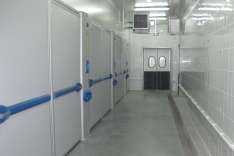Single-stage incubation is the current standard

Single-stage incubation systems are gradually gaining ground. This is not without reason. The advantages of this system include better hatching results, as well as stronger chicks. Total control and flexibility of single-stage systems allow for continued strides towards developing genetically faster growing and better converting birds.
By Jerry Garrison, Jamesway Incubator Company, Cambridge, ON, Canada
Single-stage incubation provides results that exceed that of multi-stage machines, with improved chick quality, improved hatch rates, and fewer cull birds. In turn, these positive results provide more viable, hydrated and healthy chicks from hatch to grow out. Results from single-stage incubation have also shown reduced mortality rates in the first week, as well as improved growth rate and feed conversion.
It is the ability to maintain complete control of the incubation parameters that allows for excellent chick quality from single-stage machines. Data has shown that not only does single-stage incubation achieve improved hatchery results, but also displays better results in grow out as well. Single-stage incubation hatch residue results have also shown reduced early and late embryo mortalities, as the noticeable increase in hatch rates reduces the number of chicks dead in tray.
Increased demands
As the poultry industry continues its advances in regard to satisfying increasing demand for rapid growing and high yielding birds, hatcheries must be able to adapt and support the consistent changes in the genetics of broiler breeders. Although many hatcheries are still operating with past standards, single-stage incubation is at the forefront of changing the mindset and the processes required today. Single-stage incubation is rapidly becoming the incubation system of choice in today’s modern poultry industry, in order to meet the increasing demands and requirements for present and future embryonic needs!
Chicks produced through the single-stage incubation process show decreased 7-day mortality rates, with research indicating that these chicks will also perform better during the entirety of their grow-out cycle as well.
Increased hatch rates
When a proper profile is followed, increased hatch results and decreases in early and late embryonic mortality are prevalent (Figure 1). Another improvement is a decrease in dead-in-shell and piped eggs. These can be attributed to the actual concept differences in the single-stage and multi-stage systems.
Multi-stage incubation operates on average due to the incubation of the varying ages of the embryos in any one incubator. Single-stage incubation is specially profiled to meet the specific needs of the embryos at each stage of embryonic development. When a proper profile is used, the single-stage incubator will maximise the incubators efficiency and produce the highest number of high quality chicks.
Customer data consistently indicates that single-stage incubation improves chick quality and field performance. Single-stage incubation allows complete control over all the parameters involved in proper incubation yielding improved results, producing a greater number of quality chicks at the lowest cost.
Hatchery labour savings
Operation flexibility in single-stage machinery can attribute to increased labour savings in the hatchery. Single-stage incubators allow for egg holding for a period of time, at egg room temperature, thereby allowing the manager to set eggs when there is available labour. Based on the high costs of labour in some parts of the world, this can be a great attributing factor to hatchery operation savings.
The Table shows the projected savings and increased earning potential offered through single-stage incubation when comparing field data from single-stage and multi-stage machinery. Numbers are based on one million chicks per week. Results show that with the use of single-stage equipment there is huge potential for increased savings and earnings, with the visible increase in liveability, together with a decrease in field mortality.
Statistics were complied from various hatcheries producing over one million chicks per week. Research was achieved through direct comparisons between single-stage and multi-stage incubators. Results show that substantial improvements can be achieved in all areas of incubation. The big profit, however, lies in the numbers carried over to processing. Assuming the cost of processed meat is 0.89 cents per lbs (per average Georgia Dock) multiplied by 2,210,300 lbs, this would equal an additional $1,967,167.00 in earnings to the pertaining company.
Demand for high quality
Consumers demand high quality, safe and healthy food. Both single-stage and multi-stage incubation can produce quality chicks when the machines are operated and maintained properly. The single-stage machinery, however, can be completely cleaned and sanitised every 18 days, which is not the case with multi-stage machines where such extensive cleaning is only possible once a year or less, making it harder to keep the machinery clean, thereby risking sanitation and cleanliness, and allowing contamination a greater chance.
Single-stage incubators offer the opportunity to sanitise the machine after each set of eggs has passed through the machine. This type of sanitation has been an ‘industry norm’ for hatchers, but it is now becoming a sanitation process that can be included in the setter operation as well.
As the production of poultry becomes more intensive, and genetic selection has allowed us to produce chickens that grow faster, it also presents the possibility of diseases. All aspects of the incubation process must establish advanced procedures to maximise the levels of sanitation and hygiene, and to therefore avoid any potential diseases or contamination.
Accountability and traceability are important advantages that can be realised by using single-stage incubation. At any given time, multi-stage incubators will have eggs at multiple stages of embryonic development. If a contamination problem arises, all of the eggs in the incubator will be exposed. This could result in the need to destroy all the eggs. In the case of a single-stage machine, all of the eggs within the machine are at the same stage of incubation, so if contamination occurs, it could mean that only one machine’s worth of eggs are destroyed. The end consumer demands accountability, and single-stage incubation has the capacity to deliver this.












